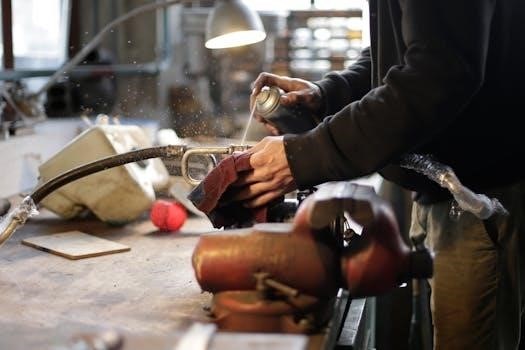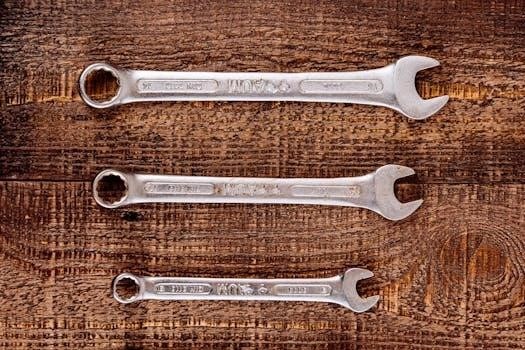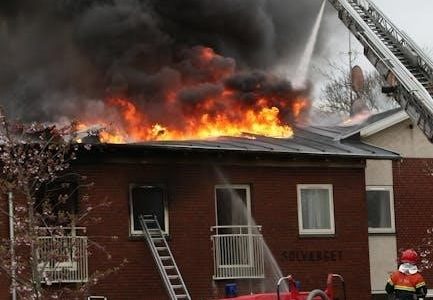Beckett Oil Burner Air Adjustment⁚ An Overview
Proper air adjustment on a Beckett oil burner is crucial for efficient and safe operation. This involves setting the air adjustment plate, often with the aid of a T500 gauge. Incorrect adjustments can lead to soot, carbon monoxide, or inefficient fuel consumption. Professional help may be needed.
Understanding the Importance of Air Adjustment
Air adjustment in a Beckett oil burner is not just a minor tweak; it’s a critical factor determining the burner’s efficiency, safety, and longevity. The correct air-to-fuel ratio is essential for complete combustion, where fuel is burned efficiently, producing heat and minimal harmful byproducts. Insufficient air results in incomplete combustion, leading to soot buildup, which can clog the burner and reduce its lifespan. It also increases the risk of carbon monoxide production, a dangerous and odorless gas. Excess air, on the other hand, can cool the flame, reducing the overall heating efficiency. Proper adjustment ensures that the burner operates as intended, achieving the optimal balance between heat output and fuel consumption. This balance not only reduces energy costs but also minimizes the environmental impact by reducing emissions. This process also prevents situations where the burner may trigger its own reset due to a lack of flame detection. Moreover, precise adjustment contributes to a healthier indoor environment by preventing the accumulation of hazardous substances. Therefore, understanding and maintaining the correct air adjustment is crucial for maintaining a safe, efficient, and long-lasting heating system. It requires a careful approach and may necessitate the use of specialized tools like the Beckett T500 gauge.
Locating the Air Adjustment Plate on Beckett Burners
Identifying the air adjustment plate on a Beckett oil burner is the first step towards proper maintenance and efficient operation. Typically, this plate is situated near the burner’s air intake, often close to the fuel pump, and is designed to regulate the amount of air entering the combustion chamber. On many Beckett models, such as the AFG, it can be found on the left side of the burner near the pump, where a collar or band with air intake slots is positioned. This adjustment mechanism may involve a sliding collar or a series of baffles. The location can vary slightly depending on the specific model, therefore, consulting the user manual for your particular burner is always advisable. The plate is often part of an assembly that includes the air band or shutter mechanism. It may be a metal plate with markings or a series of slots that allow for fine-tuning. Some models might also have an acorn nut or a splined nut that needs to be loosened to adjust the plate position. Familiarizing yourself with the precise location of the air adjustment plate is paramount for making accurate adjustments and ensuring your heating system functions safely and effectively. Incorrect adjustments will cause a variety of problems, including inefficient fuel burning and potential safety risks. If uncertain, seek guidance from a qualified technician.

Initial Air Adjustment Plate Setting
When initiating the setup of a Beckett oil burner, the initial air adjustment plate setting is a crucial step that significantly impacts combustion efficiency. Typically, the manufacturer provides a recommended starting position for the air adjustment plate, often detailed in the burner’s instruction manual. This setting serves as a baseline for most applications and is usually a good starting point for optimal performance. For example, some manuals may specify a particular setting using a chart or table which corresponds to the specific model and configuration. It is important to note that the initial setting may not always be the perfect setting, as various factors such as the type of fuel, nozzle size, and venting can affect optimal air-fuel mixture. The initial setting generally aims to allow sufficient air for clean and complete combustion, while preventing excessive air that can cool the flame and reduce efficiency. Often, you will find this initial position described as a specific distance or alignment in relation to another burner component. The goal is to establish a safe and relatively efficient combustion process before making further fine-tuning adjustments. Before changing the initial setting, always double-check the documentation and recommendations for your specific model. This will serve as a foundation for subsequent adjustments and will help to ensure that the burner operates safely and effectively. Remember, a proper initial setting is a safeguard against potential combustion issues.
Using the Beckett T500 Gauge
The Beckett T500 gauge is an essential tool for precisely adjusting the air settings on Beckett oil burners. This gauge allows for accurate measurement of the air band and head positions, ensuring optimal combustion. To use the T500 gauge, first ensure that the burner is off and the power is disconnected. The gauge is then placed against the burner’s air tube, and the sliding nozzle is adjusted until the measurement is consistent with the recommended setting in the burner’s manual. It is crucial to align the gauge correctly to get an accurate reading. The T500 gauge often measures the distance between the nozzle and the end of the air tube, or, in some cases, the position of the head assembly. The gauge helps to eliminate guesswork and provides a repeatable and reliable method for achieving the proper air adjustments. Proper use of the T500 gauge helps in ensuring that the air-fuel mixture is within the recommended limits, which is critical for efficient and clean burning. By carefully following the gauge’s instructions and the burner manual, technicians can fine-tune the air settings for optimal combustion, reducing soot and improving the overall efficiency of the heating system. The gauge is particularly useful when troubleshooting or when making adjustments after the initial installation, as it provides a standardized reference point for settings. Always refer to the specific model’s instructions when using the T500 gauge.
Adjusting the Head Position
Adjusting the head position on a Beckett oil burner is a critical step in optimizing combustion. The head, or air adjustment plate, controls the airflow into the burner, directly impacting the air-fuel mixture. To adjust it, begin by locating the splined and acorn nuts that secure the head assembly. After carefully loosening these nuts, the head can be moved forward or backward to change the air inlet. It’s important to make these adjustments incrementally, often by only one position at a time, to observe the effects on the flame. If combustion results show a need for change, further small adjustments may be necessary. These changes can affect the flame color and its efficiency, so it’s essential to monitor these aspects closely. The aim is to achieve a clean, bright flame without excessive smoke or soot. The burner head adjustment is often done in conjunction with the air adjustment plate to find the optimal setup. It’s essential to consult the burner’s manual for specific recommended settings. After making adjustments, ensure that all nuts and hardware are tightened to prevent any movement during operation. Correct head positioning is vital for both the performance and safety of the burner. If you are not familiar with these adjustments, consider consulting with a professional.

Troubleshooting Common Issues
When dealing with a Beckett oil burner, several common issues can arise, often related to air adjustment. Black smoke indicates insufficient air, suggesting the need to open the air adjustment plate more. Conversely, a noisy flame might mean too much air, requiring a slight reduction. If the burner frequently goes into reset mode despite an active flame, it may be due to a faulty cad cell or incorrect air settings leading to poor combustion. Soot accumulation, visible around the burner and in the chimney, is another sign of improper air-fuel mixture. Make sure there is no lint accumulation on the air handling parts, and that the oil being delivered is not heavier than specified. Additionally, if the burner fails to ignite properly, this could also be tied to incorrect air adjustments or a blocked air inlet. Always check for any restrictions in the combustion air ventilation openings. It’s crucial to address these problems promptly to prevent damage and ensure safe operation. If these troubleshooting steps don’t resolve the issues, seeking help from a qualified technician is a good idea. Remember, correct air adjustments are critical for preventing safety hazards and maintaining efficiency.

The Significance of Proper Combustion Air
Proper combustion air is absolutely essential for the safe and efficient operation of a Beckett oil burner. It ensures that the fuel is burned completely, maximizing heat output and minimizing waste. When the air supply is inadequate, the oil doesn’t combust fully, resulting in the production of soot, carbon monoxide, and other harmful pollutants. These byproducts can be dangerous to your health, as well as damaging to the heating system. In contrast, if there is too much air, the flame can cool down excessively, which can also reduce efficiency and cause problems. The right amount of air is critical to maintaining an optimal flame which is crucial for effective heat transfer. Furthermore, proper combustion air helps to prevent the buildup of deposits within the burner and chimney, extending the lifespan of the heating system. It is important to note that correct air adjustment not only benefits the burner, but also impacts the overall air quality within the living space. Therefore, ensuring the right balance of air intake is a critical part of maintaining a safe and efficient home heating system. This delicate balance is what makes proper adjustment so vital.
Safety Precautions During Adjustment
When adjusting a Beckett oil burner, safety must always be the top priority. Before commencing any work, it’s absolutely essential to disconnect the power supply to the burner. This prevents the risk of electrical shock, which could be fatal. Never attempt adjustments while the burner is actively firing; ensure that it is completely shut down and cool. Always be aware of the potential for fire, soot, and carbon monoxide poisoning, which could result from improper adjustments. It’s highly recommended to wear appropriate safety gear, including gloves and eye protection, to minimize any potential risks. Never restrict the air inlet openings to the burner or the combustion air ventilation openings in the room as this could lead to very dangerous situations. If you are not entirely comfortable with the process or if you are unsure about any aspect of the adjustment procedure, it is always best to seek professional help from a qualified technician. Remember, incorrect adjustments could result in severe personal injury, death, or substantial property damage. Therefore, taking all necessary precautions is not just advisable, it is absolutely crucial.
Professional Assistance and Resources
When dealing with the complexities of Beckett oil burner air adjustments, it’s crucial to recognize when professional assistance is needed. If you find yourself uncertain about any step in the adjustment process, or if you’re experiencing persistent issues, it’s best to consult a qualified HVAC technician. Many professionals specialize in Beckett burners and possess the expertise to accurately diagnose and rectify any problems. These technicians can ensure proper burner operation, optimizing efficiency and safety. Furthermore, a variety of resources are available to aid in understanding Beckett burners. Beckett itself provides technical support and training materials. Their official website offers manuals, specifications, and troubleshooting guides, which can be invaluable tools for both homeowners and professionals. Additionally, there are numerous online forums and communities where users share their experiences and advice. Local heating suppliers and industry associations can also be valuable sources of knowledge and support. Don’t hesitate to leverage these resources to enhance your understanding and ensure your Beckett burner is functioning correctly. Remember, seeking professional help is often the safest and most effective approach when dealing with complex machinery.

Maintenance and Long-Term Performance
Maintaining your Beckett oil burner is essential for ensuring its long-term performance and efficiency. Regular maintenance goes beyond just air adjustments and includes several key checks. Start by periodically inspecting the burner for any signs of wear or damage, such as loose connections or corroded components. Cleaning is also critical; ensure that the air handling parts are free from lint and debris, which can obstruct airflow and lead to inefficient combustion. The fuel filter should be replaced regularly to prevent clogs and ensure a steady fuel supply. Consider having a professional perform an annual tune-up that includes checking the nozzle, electrodes, and other vital components. Proper maintenance not only extends the life of your burner but also improves its efficiency, reducing fuel consumption and lowering heating costs. It also helps to prevent potential problems that could lead to breakdowns and costly repairs. Neglecting regular maintenance can result in decreased performance, increased emissions, and even safety hazards. By investing time in regular care, you are ensuring your Beckett burner operates reliably for many years to come. Remember, a well-maintained burner is a safe and efficient burner.



